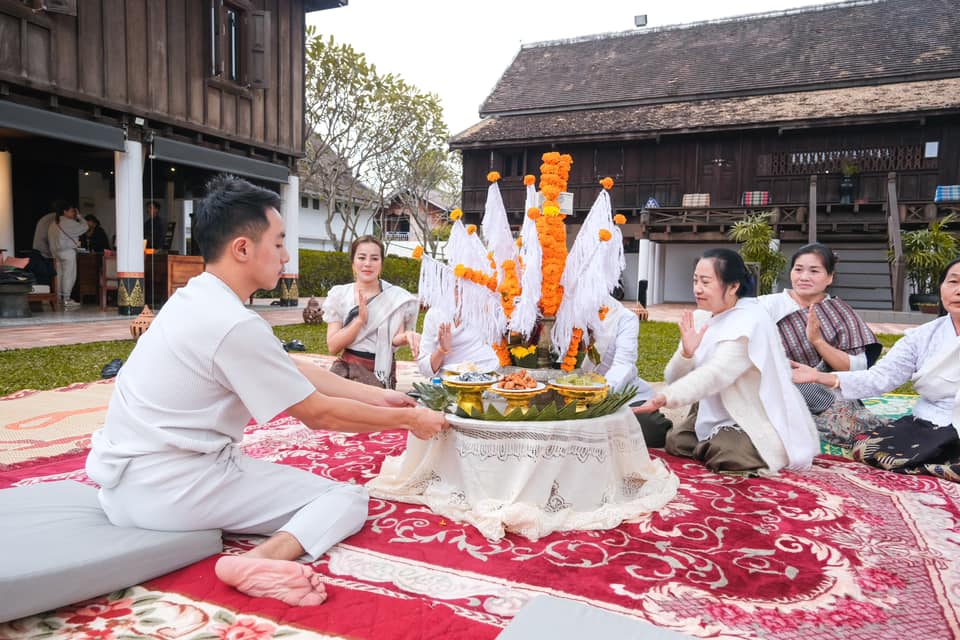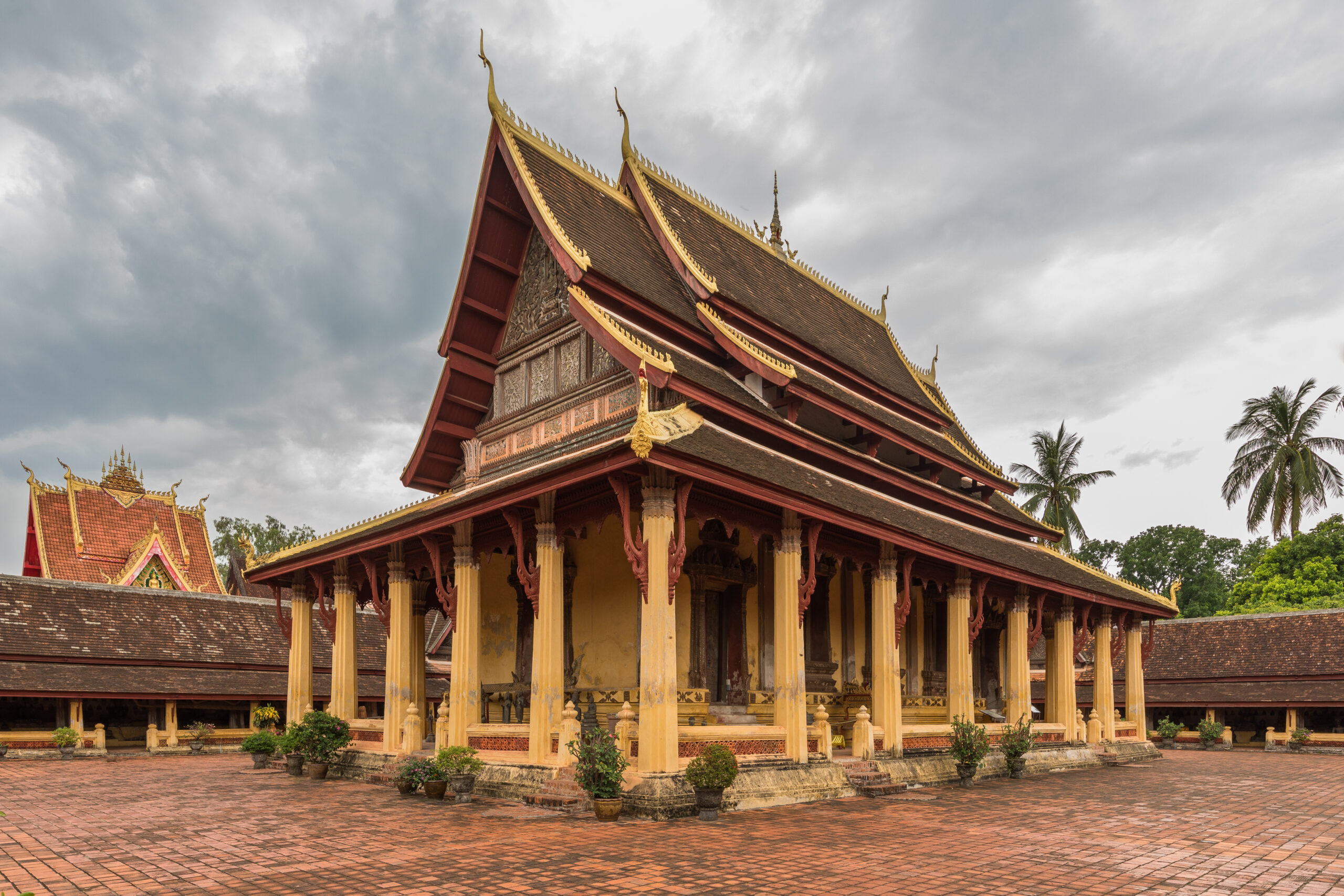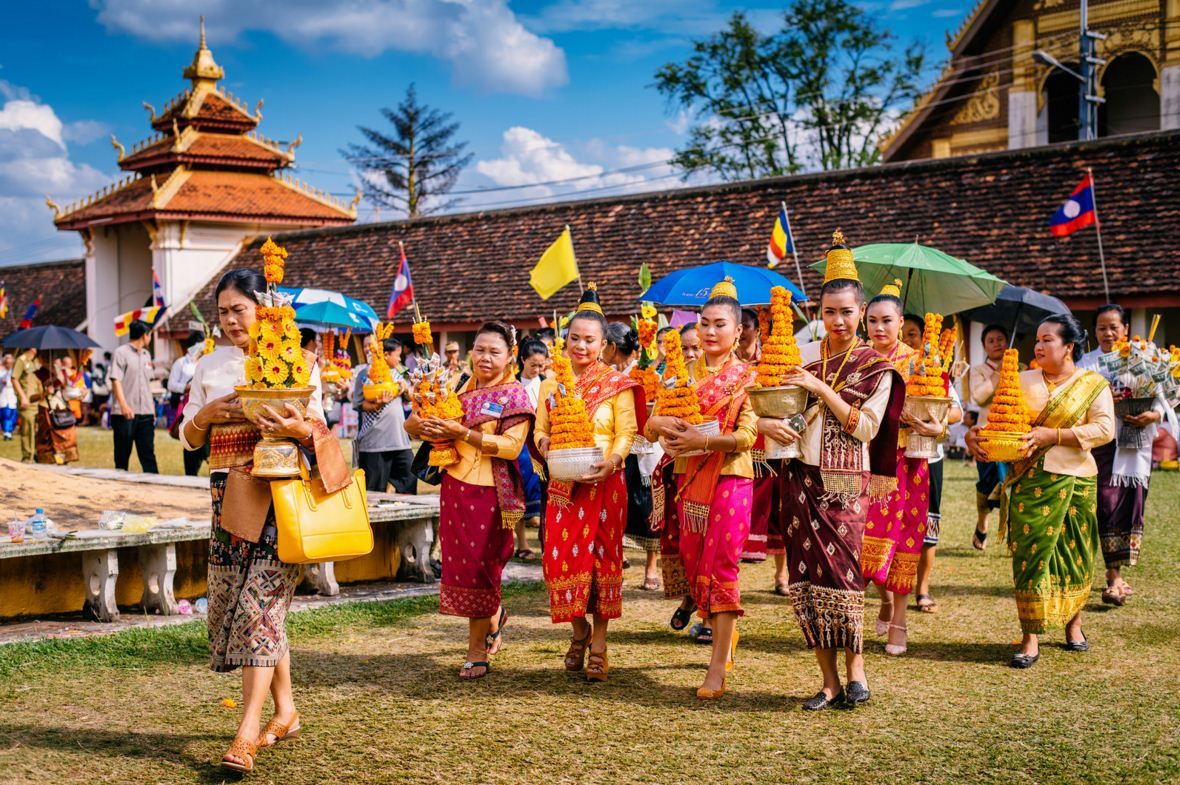1. Overview
The Baci Ceremony, also known as “Sou Khuan,” is a deeply spiritual and cultural ritual in Laos. It is performed to restore balance and harmony within individuals and the community by calling back wandering spirits. The ceremony is performed during various significant life events and is a vital part of Lao culture.
- Name: Baci Ceremony
- Location: Vientiane, Laos (and other regions of Laos)
- Coordinates: Typically central Vientiane (17.9750° N, 102.6340° E)
- Best experienced: As part of a cultural or spiritual visit to Laos
2. History of the Place
The Baci Ceremony has ancient origins in Laos, rooted in the belief that humans have 32 spiritual entities (khwan) that protect their body and mind. If these spirits wander away, illness or misfortune can occur. The ceremony calls back these spirits to restore health, balance, and happiness.
- Origin: Dates back over 1,000 years
- Spiritual Roots: Centers around the belief in khwan (spiritual entities)
- Main Instrument: White cotton strings, symbolizing the spiritual connection
- Ceremony Leader: Typically an elder or former monk conducts the ceremony
- Rites of Passage: Performed for weddings, births, healing, and welcoming guests
- Community Bonding: The ceremony fosters unity and well-wishing
- Symbolism: Pha Khuan (decorative arrangements of flowers and leaves) are central to the ritual
- Blessings: Tying of strings around wrists while reciting prayers and blessings
- Festivals: Performed during important Lao festivals, including Pi Mai (Lao New Year)
3. What Makes the “Baci Ceremony” Popular? + Recommended YouTube Video
The Baci Ceremony is deeply embedded in Lao culture, and it is popular for its emotional and spiritual significance. It is a beautiful expression of unity, gratitude, and spiritual well-being. Visitors to Laos often seek to participate in the ceremony to experience its cultural richness and spiritual depth.
- Spiritual Significance: A deeply rooted ritual in Lao culture
- Cultural Celebration: Brings together family, friends, and communities
- Traditional Beliefs: Connects to the notion of balance and spiritual protection
- Visitors’ Experience: A unique way to experience Lao spirituality and traditions
4. Overall Ratings (1 to 5 Stars)
The Baci Ceremony is highly rated by visitors and locals alike for its cultural richness and the spiritual experience it offers. The ceremony is a cherished part of Lao life and has a profound impact on participants, making it an unforgettable experience for those seeking a deeper connection with Lao traditions.
- Overall Rating: ⭐⭐⭐⭐⭐ (5/5)
- Cultural Impact: ⭐⭐⭐⭐⭐ (5/5)
- Authenticity: ⭐⭐⭐⭐⭐ (5/5)
- Atmosphere & Environment: ⭐⭐⭐⭐☆ (4/5)
- Accessibility: ⭐⭐⭐⭐☆ (4/5)
- Tourist Friendliness: ⭐⭐⭐⭐⭐ (5/5)
5. Weather
The best time to experience the Baci Ceremony is during the dry season when the weather is cooler and more comfortable for outdoor activities. The ceremony itself is often held indoors, but outdoor festivities may be affected by heavy rain during the wet season.
- Best Time to Visit: November to February (dry season)
- Temperature Range: 25–30°C (77–86°F)
- Wet Season: May to October, frequent rainfall
- Dry Season: More suitable for outdoor events and ceremonies
6. Nearest Five Hotels
For those visiting Vientiane to experience the Baci Ceremony, here are five nearby hotels that offer convenience and comfort:
- Sabaidee@Lao Hotel: Comfortable and centrally located
- City Inn Vientiane: Affordable and well-situated
- Lao Plaza Hotel: Luxury with excellent facilities
- Vientiane Garden Hotel: Quiet and scenic, with easy access to the city
- Ibis Vientiane Nam Phu: Budget-friendly and centrally located
7. Timings
Baci Ceremonies are typically performed in the evenings, especially for personal events like weddings or birthdays. However, there are also public ceremonies held during Lao festivals. It’s important to check the schedule in advance, as ceremonies during festivals can have varying times.
- Opening Hours: Varies by event, generally in the evening
- Best Time: For personal ceremonies, evening is most common
- Public Ceremonies: Schedule varies depending on the festival
8. Time Required to Visit
The Baci Ceremony itself usually lasts around 1 to 2 hours, depending on the number of participants and the complexity of the rituals. If attending a public festival, the ceremony may be part of a larger cultural celebration, extending the experience.
- Visit Duration: 1–2 hours
- Full Festival Experience: Can last several hours, including celebrations and festivities
- Ideal for a cultural evening out
9. Entry Fees & Ticket Booking Details
There may be a small fee to attend the Baci Ceremony, particularly if it’s part of a special cultural event or festival. Some venues, like Villa Lao, may include the ceremony as part of a dining experience. For public events, the ceremony is typically free, but donations are appreciated.
- Entry Fee: Varies by venue and occasion, typically between 10,000–50,000 Kip
- Booking: Recommended for private ceremonies; festival events may not require booking
- Special Ceremonies: Can be booked in advance through cultural tour operators or local venues
10. Things to See & Do
During the Baci Ceremony, visitors can observe the rituals, participate in the tying of cotton threads, and enjoy the communal atmosphere. Afterward, many ceremonies conclude with traditional Lao music, dancing, and a celebratory meal. The experience is both spiritually enriching and culturally informative.
- Observe the spiritual ceremony and prayers
- Participate by tying the cotton threads for blessings
- Learn about the significance of each part of the ceremony
- Enjoy the traditional Lao music and dance
- Share in a communal meal following the ceremony
11. Best Time to Visit
The best time to visit for a Baci Ceremony is during Lao festivals like the Rocket Festival or That Luang Festival when large public ceremonies are held. Visiting during the dry season (November to February) ensures more pleasant weather for both the ceremony and surrounding festivities.
- Best Time: During cultural festivals or personal life events like weddings
- Season: November to February for the best weather
- Time of Day: Evening ceremonies are common for personal events
12. Nearest Parking Spots
For those attending the Baci Ceremony at specific venues, parking is usually available nearby. Some venues, like Villa Lao, may provide parking spaces for visitors, while public ceremonies at cultural centers or temples may require street parking or nearby public lots.
- Street Parking: Available near most cultural venues
- Public Parking: Available near the National Culture Hall or temples
- Tuk-Tuks: Convenient for easy access without parking concerns
13. Tips for Visitors
When attending the Baci Ceremony, remember to dress modestly (covering shoulders and knees) to respect local traditions. Participating in the ceremony involves tying the white cotton threads, and it’s customary to wait for permission before photographing the ceremony.
- Dress Modestly: Ensure your shoulders and knees are covered
- Be Respectful: Maintain quiet during the ceremony and respect cultural customs
- Ask Before Photographing: Always ask permission before taking photos of the ceremony
- Participate: Feel free to take part in the tying of the cotton threads for blessings
14. How to Reach the Place
The Baci Ceremony can be attended at various cultural venues and private locations in Vientiane. If attending a public ceremony or festival, most venues are within walking distance from central Vientiane. Tuk-tuks, taxis, and bicycles are convenient transportation options for reaching the sites.
- By Tuk-Tuk: A convenient, affordable option for short trips
- By Bicycle: Renting a bike is a popular way to explore the city
- By Taxi: Quick and comfortable for more distant venues
- Walking: Convenient for central locations in Vientiane
15. Nearby Attractions to Combine for the Visit
While attending the Baci Ceremony, consider visiting nearby landmarks and attractions. Many temples, parks, and cultural sites are located within walking distance of the ceremony venues.
- Patuxai Monument: Victory monument with panoramic city views
- Wat Si Saket: The oldest surviving temple in Vientiane
- That Luang Stupa: Laos’ most iconic landmark
- COPE Visitor Centre: Museum showcasing Laos’ recent history
- Mekong Riverfront: Great for evening walks and local food



